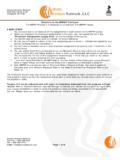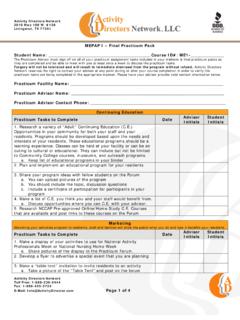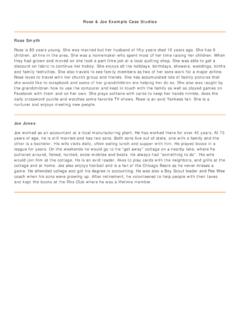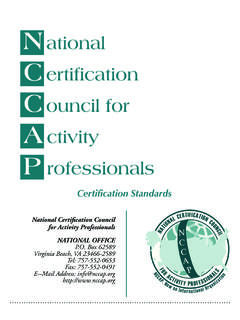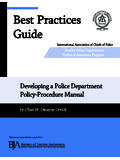Transcription of Manual of Hospice Care and Palliative Care - …
1 Manual of Hospice care and Palliative care International Association for Hospice &. Palliative care Promoting Hospice & Palliative care Worldwide The IAHPC Manual of Palliative care 2nd Edition Published by IAHPC Press ISBN 0-9758525-1-5. Derek Doyle OBE, DSc, MD, FRCSE, FRCP (Lond & Edin) & FRCGP. Roger Woodruff MBBS, FRACP & FAChPM. The International Association for Hospice and Palliative care (IAHPC) is a not for profit organization committed to the development of Palliative care world-wide. For this to happen there needs to be better professional education, and health care professionals willing to acquire the essential knowledge and skills necessary to practice Palliative care . The IAHPC is conscious of the fact that in many countries Palliative care textbooks and practice manuals are expensive or difficult to obtain. Many medical libraries do not hold copies of Palliative care journals or reference books, of which there are many. Readers are, however, reminded that the IAHPC runs a Clearing House Project that distributes donated books and journals to colleagues otherwise unable to purchase them, on application to the Executive Director Contact Here The IAHPC Manual of Palliative care is not intended to be a substitute for any textbook or reference book.
2 Nor do its authors claim that it is exhaustive and comprehensive. It does however contain much of what is necessary for the day-to-day practice of Palliative care . The IAHPC offers this Manual in the hope that doctors and nurses world- wide will find the information in it helpful, will feel free to download file:////Lap1/ (1 of 3) [3/5/2008 12:16:14 AM]. Manual of Hospice care and Palliative care whatever parts of it they want, and will make its existence known to colleagues also seeking to improve their skills so as to offer better care to their terminally ill patients. We ask two things of those who use it. First that they inform the Executive Director the IAHPC Contact Here what they think about it and what other material they would have liked included. Second, that if they have it translated into another language they again inform the Executive Director so that she may know where to refer any enquirers who also want it in that language.
3 The IAHPC hopes that this Manual , like its bookshop, its Traveling Fellowships, its bursaries and its newsletter will help to bring Palliative care to the thousands of people who still suffer appallingly and quite unnecessarily at the end of life. Before using the Manual , please read the Disclaimer. Disclaimer The information contained in this Manual is presented for the purpose of educating health care providers about certain aspects of Palliative care . The Information should not be relied upon as complete or accurate, nor should it be relied on to suggest a course of treatment for a particular individual. Patients with health care related questions or concerns are advised to contact a physician or other qualified health care provider. The information contained in this Manual is provided "AS IS". without warranty, express or implied. The IAHPC and IAHPC. Press make no warranty as to the reliability, accuracy, timeliness, usefulness, adequacy, completeness or suitability of the Information.
4 Whilst every effort has been made to ensure that the patient care recommendations in this Manual are correct and in keeping with accepted standards of practice at the time of publication, the authors, the IAHPC and IAHPC Press cannot be held liable or responsible for any errors or omissions, or for any harm or damage resulting from the use of the information contained in this publication. It is the responsibility of the reader, before using any drug, to consult the manufacturer's product information in order to check file:////Lap1/ (2 of 3) [3/5/2008 12:16:14 AM]. Manual of Hospice care and Palliative care recommended doses, warnings and contraindications. This is particularly important with new or infrequently used drugs. TOP OF PAGE. file:////Lap1/ (3 of 3) [3/5/2008 12:16:14 AM]. TABLE OF CONTENTS - The IAHPC Manual of Palliative care TABLE OF CONTENTS. I. principles and Practice of Palliative care DEFINITIONS. FAQS. THE NEED FOR Palliative care .
5 THE GOALS OF Palliative care . Palliative care AND SUFFERING: INTERPROFESSIONAL care . MULTIDISCIPLINARY and INTERPROFESSIONAL TEAMS. principles OF Palliative care . COMMUNICATION WITH PATIENTS. ADVANCE care PLANNING. MODELS OF care . INTEGRATION of Palliative care into CLINICAL care . BARRIERS to Palliative care . II. Ethical Issues principles OF MEDICAL ETHICS. COMMUNICATION AND DISCLOSURE. WITHHOLDING AND WITHDRAWING TREATMENTS. ARTIFICIAL NUTRITION. ARTIFICIAL HYDRATION. EUTHANASIA AND PHYSICIAN-ASSISTED SUICIDE. ETHICS IN RESEARCH. JUSTICE AND RESOURCE ALLOCATION. III. Pain IV. Symptom Control RESPIRATORY. breathlessness cough terminal respiratory congestion file:////Lap1/ (1 of 3) [3/5/2008 12:16:16 AM]. TABLE OF CONTENTS - The IAHPC Manual of Palliative care GASTROINTESTINAL. nausea and vomiting bowel obstruction constipation CONSTITUTIONAL. anorexia weight loss weakness and fatigue NEUROLOGICAL. acute confusion and delirium terminal restlessness V.
6 Psychosocial PSYCHOLOGICAL DISTRESS. DEPRESSION. ANXIETY. SPIRITUAL AND EXISTENTIAL DISTRESS. VI. Organizational Aspects of Palliative care HOW TO START A Palliative care SERVICE. REGULATION AND ACCREDITATION IN Palliative care . EDUCATION AND TRAING FOR SERVICE STAFF. EXTERNAL EDUCATION AND TRAINING. INFORMING PEOPLE ABOUT Palliative care . file:////Lap1/ (2 of 3) [3/5/2008 12:16:16 AM]. TABLE OF CONTENTS - The IAHPC Manual of Palliative care STRESS IN Palliative care . Abbreviations file:////Lap1/ (3 of 3) [3/5/2008 12:16:16 AM]. Manual of Hospice care and Palliative care - principles and Practice I. principles and Practice of Palliative care . CONTENTS. DEFINITIONS. FAQs THE NEED FOR Palliative care . THE GOALS OF Palliative care . Palliative care AND SUFFERING: INTERPROFESSIONAL care . MULTIDISCIPLINARY and INTERPROFESSIONAL TEAMS. principles OF Palliative care . COMMUNICATION WITH PATIENTS. ADVANCE care PLANNING. MODELS OF care . INTEGRATION OF Palliative care INTO CLINICAL care .
7 BARRIERS TO Palliative care .. DEFINITIONS. Palliative care is the care of patients with active, progressive, far-advanced disease, for whom the focus of care is the relief and prevention of suffering and the quality of life. file:////Lap1/ (1 of 24) [3/5/2008 12:16:21 AM]. Manual of Hospice care and Palliative care - principles and Practice The following should be noted active disease: this activity can be confirmed and measured objectively by clinical examination and investigations progressive disease: this too can be assessed clinically far-advanced disease: more difficult to define but examples are extensive metastatic disease in cancer refractory cardiac failure total dependency in neurodegenerative conditions or A. focus on the quality of life is the key feature of the definition it is person-oriented, not disease-oriented it is not primarily concerned with life prolongation (nor with life shortening). it is not primarily concerned with producing long term disease remission it is holistic in approach and aims to address all the patient's problems, both physical and psychosocial it uses a multidisciplinary or interprofessional approach involving doctors, nurses and allied health personnel to cover all aspects of care it is dedicated to the quality of whatever life remains for the patient Palliative care is appropriate for all patients with active, progressive, far-advanced disease and not just patients with cancer Palliative care is appropriate for patients receiving continuing therapy for their underlying disease Palliative care should never be withheld until such time that all treatment alternatives for the underlying disease have been exhausted.
8 The message of Palliative care is that whatever the disease, however advanced it is, whatever treatments have already been given, there is always something which can be done to improve the quality of the life remaining to the patient.. file:////Lap1/ (2 of 24) [3/5/2008 12:16:21 AM]. Manual of Hospice care and Palliative care - principles and Practice WORLD HEALTH ORGANIZATION DEFINITION. Palliative care is an approach that improves the quality of life of patients and their families facing the problems associated with life-threatening illness, through the prevention and relief of suffering by means of early identification and impeccable assessment and treatment of pain and other problems, physical, psychosocial and spiritual. Palliative care Provides relief from pain and other distressing symptoms Affirms life and regards dying as a normal process Intends neither to hasten or postpone death Integrates the psychological and spiritual aspects of patient care Offers a support system to help patients live as actively as possible until death Offers a support system to help the family cope during the patient's illness and in their own bereavement Uses a team approach to address the needs of patients and their families, including bereavement counselling, if indicated Will enhance quality of life, and may also positively influence the course of illness Is applicable early in the course of illness, in conjunction with other therapies that are intended to prolong life, such as chemotherapy or radiation therapy, and includes those investigations needed to better understand and manage distressing clinical complications.
9 FAQs Is Palliative care the same as Hospice care ? Yes, the principles are the same. Hospice means different things in different countries - it is variously used to refer to a philosophy of care , to the buildings where it is practised, to care offered by unpaid volunteers, or to care in the final days of life it is better to adopt and use the term Palliative care Should a Palliative care service provide care for patients with chronic file:////Lap1/ (3 of 24) [3/5/2008 12:16:21 AM]. Manual of Hospice care and Palliative care - principles and Practice diseases? No, although their care is important. patients with chronic conditions such as rheumatoid arthritis, degenerative diseases, diabetes mellitus and similar conditions usually do not have active, progressive, far-advanced disease nevertheless, many of the principles of Palliative care are appropriate to the management of patients with chronic diseases Should a Palliative care service provide care for patients with incurable diseases?
10 No, although their care is important. as with patients with chronic diseases, these patients usually do not have active, progressive, far-advanced disease nevertheless, many of the principles of Palliative care are appropriate to the management of patients with incurable diseases Should a Palliative care service provide care for patients incapacitated by their disease? No, although their care is important. patients incapacitated by psychiatric illness, cerebrovascular accidents, trauma, dementia and the like deserve special care but they usually do not have active, progressive, far-advanced disease nevertheless, many of the principles of Palliative care are appropriate to the management of patients incapacitated by their disease Should a Palliative care service provide care for the elderly? No, although their care is important. many patients needing Palliative care are elderly but they need Palliative care because of the underlying disease from which they are suffering, not because of their age nevertheless, many of the principles of Palliative care are appropriate to the management of the elderly Is Palliative care just Terminal care ?



